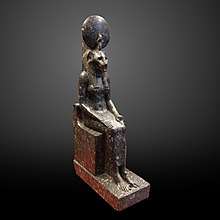Unut
| Wenut[1] in hieroglyphs |
|---|

Unut, alt. Wenut or Wenet, is a prehistoric Egyptian snake goddess.
Originally, she had the form of a snake and was called "The swift one". She came from the fifteenth Upper Egyptian province and was worshipped with Thoth at its capital Hermopolis (in Egyptian: Wenu). Later she was depicted with a woman's body and a hare's head.[2] She was taken into the cult of Horus and later of Ra.
Her name can be represented with five different hieroglyphs, but she appears rarely in literature and inscriptions. An exceptional sculpture of her has been found by American archaeologists and is probably the only one of its kind found so far. Her name was taken into the highest royal position just once in the long Egyptian history. The only king bearing her name was Unas. Her male companion is Wenenu, who was sometimes regarded as a form of Osiris or Ra.[3]
References
| Wikimedia Commons has media related to Unut. |
- ↑ Wörterbuch, I., p.317
- ↑ Erik Hornung, Conceptions of God in Ancient Egypt: The One and the Many, Cornell University Press 1996, ISBN 0-8014-8384-0, p. 82
- ↑ Richard Wilkinson: The Complete Gods and Goddesses of Ancient Egypt. London, Thames and Hudson, 2003. ISBN 978-0500051207 p. 199